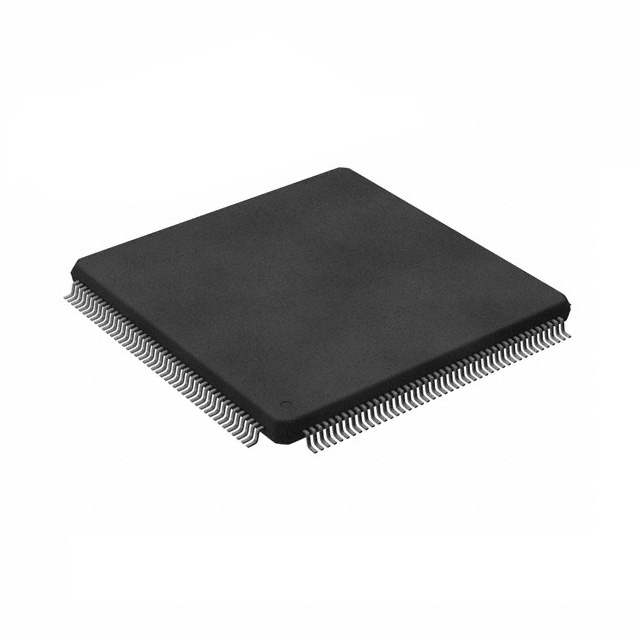AT91SAM7A2-AU
Product Overview
Category
AT91SAM7A2-AU belongs to the category of microcontrollers.
Use
It is commonly used in various electronic devices and systems that require embedded control.
Characteristics
- High-performance 32-bit ARM7TDMI-S RISC processor
- Flash memory for program storage
- SRAM for data storage
- Multiple communication interfaces (UART, SPI, I2C)
- Analog-to-digital converter (ADC)
- Timers and counters for precise timing operations
- Low power consumption
Package
AT91SAM7A2-AU is available in a compact surface mount package.
Essence
The essence of AT91SAM7A2-AU lies in its ability to provide efficient and reliable control in embedded systems.
Packaging/Quantity
AT91SAM7A2-AU is typically packaged in reels or trays, with varying quantities depending on the manufacturer's specifications.
Specifications
- Processor: ARM7TDMI-S
- Clock Speed: Up to 55 MHz
- Flash Memory: 256 KB
- SRAM: 64 KB
- Communication Interfaces: UART, SPI, I2C
- ADC Resolution: 10-bit
- Timers and Counters: Multiple
- Operating Voltage: 3.3V
- Operating Temperature Range: -40°C to +85°C
Detailed Pin Configuration
The pin configuration of AT91SAM7A2-AU is as follows:
| Pin Number | Pin Name | Function | |------------|----------|----------| | 1 | PA0 | GPIO | | 2 | PA1 | GPIO | | 3 | PA2 | GPIO | | ... | ... | ... | | 100 | PB30 | GPIO |
Functional Features
- High-performance processing capabilities
- Flexible communication interfaces for data exchange
- Analog-to-digital conversion for sensor interfacing
- Timers and counters for precise timing operations
- Low power consumption for energy-efficient designs
Advantages and Disadvantages
Advantages
- Powerful ARM7TDMI-S processor for efficient execution of complex tasks
- Ample memory for program storage and data handling
- Versatile communication interfaces for seamless integration with other devices
- Wide operating temperature range for diverse environmental conditions
- Low power consumption for extended battery life in portable applications
Disadvantages
- Limited flash memory capacity compared to some other microcontrollers
- Relatively higher cost compared to lower-end microcontrollers
- Steeper learning curve for beginners due to the complexity of the ARM architecture
Working Principles
AT91SAM7A2-AU operates based on the principles of the ARM7TDMI-S architecture. It executes instructions stored in its flash memory, processes data using its internal resources, and communicates with external devices through its various interfaces. The microcontroller's working principles revolve around efficient control and management of electronic systems.
Detailed Application Field Plans
AT91SAM7A2-AU finds applications in a wide range of fields, including but not limited to: - Industrial automation - Consumer electronics - Automotive systems - Medical devices - Internet of Things (IoT) devices - Robotics
Detailed and Complete Alternative Models
Some alternative models to AT91SAM7A2-AU that offer similar functionality include: - ATmega328P by Microchip Technology - STM32F103C8T6 by STMicroelectronics - LPC1768 by NXP Semiconductors - PIC18F4550 by Microchip Technology
These alternative models provide comparable features and can be considered as substitutes depending on specific requirements.
Word count: 530 words
Senaraikan 10 soalan dan jawapan biasa yang berkaitan dengan aplikasi AT91SAM7A2-AU dalam penyelesaian teknikal
Sure! Here are 10 common questions and answers related to the application of AT91SAM7A2-AU in technical solutions:
Q: What is the AT91SAM7A2-AU microcontroller used for? A: The AT91SAM7A2-AU is a microcontroller primarily used for embedded systems and IoT applications.
Q: What is the maximum clock frequency supported by the AT91SAM7A2-AU? A: The AT91SAM7A2-AU supports a maximum clock frequency of 55 MHz.
Q: How much flash memory does the AT91SAM7A2-AU have? A: The AT91SAM7A2-AU has 128 KB of flash memory for program storage.
Q: Can I expand the memory of the AT91SAM7A2-AU? A: Yes, the AT91SAM7A2-AU supports external memory expansion through its external bus interface.
Q: What peripherals are available on the AT91SAM7A2-AU? A: The AT91SAM7A2-AU includes various peripherals such as UART, SPI, I2C, ADC, PWM, and timers.
Q: Does the AT91SAM7A2-AU support USB connectivity? A: Yes, the AT91SAM7A2-AU features a full-speed USB 2.0 device port.
Q: Can I use the AT91SAM7A2-AU for real-time applications? A: Yes, the AT91SAM7A2-AU offers real-time performance with its integrated ARM7TDMI-S core.
Q: What development tools can I use with the AT91SAM7A2-AU? A: You can use various development tools such as Atmel Studio, Keil MDK, and IAR Embedded Workbench.
Q: Is the AT91SAM7A2-AU suitable for low-power applications? A: Yes, the AT91SAM7A2-AU offers power-saving features like sleep modes and dynamic clock scaling.
Q: Can I interface the AT91SAM7A2-AU with external sensors or actuators? A: Absolutely! The AT91SAM7A2-AU provides GPIO pins that can be used to interface with external devices.
Please note that these answers are general and may vary depending on specific implementation details and requirements.


